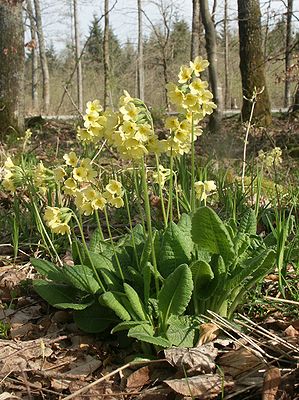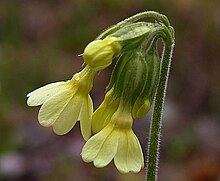High cowslip
| High cowslip | ||||||||||||
|---|---|---|---|---|---|---|---|---|---|---|---|---|

High cowslip ( Primula elatior ) |
||||||||||||
| Systematics | ||||||||||||
|
||||||||||||
| Scientific name | ||||||||||||
| Primula elatior | ||||||||||||
| ( L. ) Hill |
The high cowslip ( Primula elatior ) is a species of plant that belongs to the genus of primroses ( Primula ). Another common name is forest cowslip (Switzerland). Its inflorescences appear as early as March as one of the first signs of spring on damp meadows, on the edge of the stream and in the alluvial forest .
description
The high cowslip is a perennial herbaceous plant that reaches heights of about 10 to 30 centimeters. The leaves, which are hairy on both sides, stand together in a basal rosette, reach a length of about 20 cm and gradually merge into the winged petiole, becoming ever narrower. The edge of the sheet shows an irregular and fine perforation.
The pale yellow flowers appear from March to May. The flowers are larger and lighter in color compared to the real cowslip ( Primula veris ). In contrast to the real cowslip, the throat of the cowslips is golden yellow and the calyx is close to the petals. In addition, the flowers are only slightly scented. However, it is primarily the different location requirements that contribute to the distinction between the two types; the real cowslip can only be found in dry meadows, bushes and light forests.
The cylindrically shaped capsule fruits of the high cowslip stand on stiff upright fruit stalks and are usually longer than the calyx.
The number of chromosomes is 2n = 22.
ecology
The cowslip nectar is located deep down in the flower tube. Therefore, only long-nosed species such as bumblebees and butterflies are considered pollinating insects . In bees , however, you can sometimes observe that they bite open the corolla tube from the outside in order to get the nectar in this way.
The cowslip is one of the so-called desiccation spreaders . The fruit capsules that contain the seeds roll back in dry weather, allowing the seeds to be scattered. In damp weather, the capsule teeth curve inward again and thus close the capsule.
The plant is used among other things, the caterpillars of the endangered butterfly species Perlbinde and Hamearis Lucina as a forage crop.
The high cowslip is attacked by the rust fungus Puccinia primulae .
Occurrence
The high cowslip is widespread in Europe and inhabits eastern Turkey , northern Iran and Armenia , Azerbaijan and Georgia in the Caucasus region and southern Siberia in the Russian Altai Republic .
The cowslip is often found in herbaceous oak and hornbeam forests , in floodplain and ravine forests and in mountain meadows. It prefers moist, nutrient-rich and base-rich, loose soil, even in shady locations. It indicates clay soil .
In the Allgäu Alps, the species in Bavaria on the Rauheck rises up to 2300 m above sea level.
After Ellenberg it is sub-oceanic spreading, a weak acid - weak base to pointer, lives on nitrogen-rich sites and is a Ordnungscharakterart of broadleaf - mixed forests and related companies (mesophytic, buchenwald like deciduous forests of Europe ( Fagetalia sylvaticae )).
Subspecies
One can distinguish the following subspecies:
- Primula elatior (L.) L. subsp. elatior
- Primula elatior subsp. amoena (M. Bieb.) Greuter & Burdet : It occurs in Turkey, Armenia and Georgia.
- Primula elatior subsp. intricata (Gren. & Godr.) Widmer : It occurs in Central and Southern Europe.
- Primula elatior subsp. leucophylla (Pax) WW Sm. & HR Fletcher : It occurs in Poland and Romania.
- Primula elatior subsp. lofthousei (Hesl.-Harr. f.) WW Sm. & HR Fletcher : It occurs only in Spain.
- Primula elatior subsp. pallasii (clay.) WW Sm. & Forrest : It occurs in the Middle East.
- Primula elatior subsp. pseudoelatior (Kusn.) WW Sm. & Forrest : It occurs in Turkey.
use
Tea is made from the flowers and roots of the high and the real cowslip , which has an expectorant and expectorant effect.
High cowslip varieties are also used as ornamental plants. The so-called Elatior hybrids Primula × polyantha are, however, despite their name, do not descendants of the High cowslip, but come from the intersection Primula veris x vulgaris , the genuine and the stems lots cowslip (see below).
literature
- Gertrud Scherf: meadow flowers. The somewhat different nature guide. blv, Munich 2004, ISBN 3-405-16909-7 .
- Erich Oberdorfer : Plant-sociological excursion flora for Germany and neighboring areas . With the collaboration of Angelika Schwabe and Theo Müller. 8th, heavily revised and expanded edition. Eugen Ulmer, Stuttgart (Hohenheim) 2001, ISBN 3-8001-3131-5 .
- Dietrich Frohne: Medicinal Plant Lexicon . A scientifically based guide. 7. completely rework. Edition. Scientific publishing house, Stuttgart 2002, ISBN 3-8047-1897-3 .
- Siegmund Seybold (Ed.): Schmeil-Fitschen interactive . CD-ROM, version 1.1. Quelle & Meyer, Wiebelsheim 2002, ISBN 3-494-01327-6 .
- Siegfried Schlosser, Lutz Reichhoff, Peter Hanelt: Wild Plants of Central Europe. Use and protection. Deutscher Landwirtschaftsverlag, Berlin 1991, ISBN 3-331-00301-8 .
Individual evidence
- ^ Erich Oberdorfer : Plant-sociological excursion flora for Germany and neighboring areas . With the collaboration of Angelika Schwabe and Theo Müller. 8th, heavily revised and expanded edition. Eugen Ulmer, Stuttgart (Hohenheim) 2001, ISBN 3-8001-3131-5 , pp. 736 .
- ↑ Peter Zwetko: The rust mushrooms Austria. Supplement and host-parasite directory to the 2nd edition of the Catalogus Florae Austriae, III. Part, Book 1, Uredinales. (PDF; 1.8 MB).
- ^ GRIN Taxonomy for Plants. Taxon: Primula elatior (L.) Hill. In: Germplasm Resources Information Network. United States Department of Agriculture - Agricultural Research Service, Beltsville Area, accessed June 4, 2011 .
- ↑ Erhard Dörr, Wolfgang Lippert : Flora of the Allgäu and its surroundings. Volume 2, IHW, Eching 2004, ISBN 3-930167-61-1 .
- ↑ Heinz Ellenberg : Vegetation of Central Europe with the Alps in an ecological, dynamic and historical perspective (= UTB for science. Large series . Volume 8104 ). 5th, heavily changed and improved edition. Eugen Ulmer, Stuttgart (Hohenheim) 1996, ISBN 3-8252-8104-3 , pp. 1053 .
- ↑ a b c d e f g K. Marhold (2011): Primulaceae. Primula elatior In: Euro + Med Plantbase - the information resource for Euro-Mediterranean plant diversity.
Web links
- High cowslip. In: FloraWeb.de.
- High cowslip . In: BiolFlor, the database of biological-ecological characteristics of the flora of Germany.
- Primula elatior (L.) L. s. l. In: Info Flora , the national data and information center for Swiss flora . Retrieved January 15, 2016.
- Distribution in the northern hemisphere from: Eric Hultén, Magnus Fries: Atlas of North European vascular plants. 1986, ISBN 3-87429-263-0 at Den virtuella floran. (swed.)
- Thomas Meyer: Cowslip data sheet with identification key and photos at Flora-de: Flora von Deutschland (old name of the website: Flowers in Swabia )



